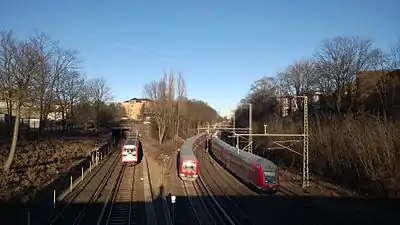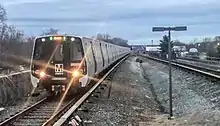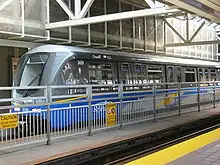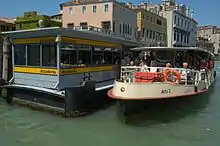Public transport
Public transport (also known as public transportation, public transit, mass transit, or simply transit) is a system of transport, in contrast to private transport, for passengers by group travel systems available for use by the general public, typically managed on a schedule, operated on established routes, and that charge a posted fee for each trip.[1][2][3] Examples of public transport include city buses, trolleybuses, trams (or light rail) and passenger trains, rapid transit (metro/subway/underground, etc.) and ferries. Public transport between cities is dominated by airlines, coaches, and intercity rail. High-speed rail networks are being developed in many parts of the world.

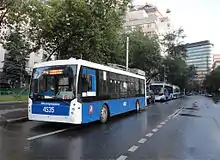
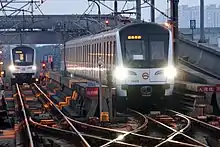

| Part of a series on |
| Transport |
|---|
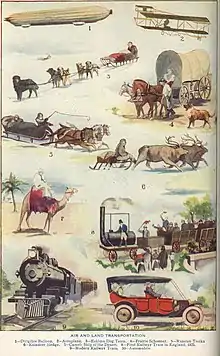 |
| Modes |
| Topics |
|
|
Most public transport systems run along fixed routes with set embarkation/disembarkation points to a prearranged timetable, with the most frequent services running to a headway (e.g.: "every 15 minutes" as opposed to being scheduled for any specific time of the day). However, most public transport trips include other modes of travel, such as passengers walking or catching bus services to access train stations.[4] Share taxis offer on-demand services in many parts of the world, which may compete with fixed public transport lines, or complement them, by bringing passengers to interchanges. Paratransit is sometimes used in areas of low demand and for people who need a door-to-door service.[5]
Urban public transit differs distinctly among Asia, North America, and Europe. In Asia, profit-driven, privately owned and publicly traded mass transit and real estate conglomerates predominantly operate public transit systems.[6][7] In North America, municipal transit authorities most commonly run mass transit operations. In Europe, both state-owned and private companies predominantly operate mass transit systems. Public transport services can be profit-driven by use of pay-by-the-distance fares or funded by government subsidies in which flat rate fares are charged to each passenger. Services can be fully profitable through high usership numbers and high farebox recovery ratios, or can be regulated and possibly subsidised from local or national tax revenue. Fully subsidised, free of charge services operate in some towns and cities.
For geographical, historical and economic reasons, differences exist internationally regarding use and extent of public transport. While countries in the Old World tend to have extensive and frequent systems serving their old and dense cities, many cities of the New World have more sprawl and much less comprehensive public transport. The International Association of Public Transport (UITP) is the international network for public transport authorities and operators, policy decision-makers, scientific institutes and the public transport supply and service industry. It has 3,400 members from 92 countries from all over the globe.
History
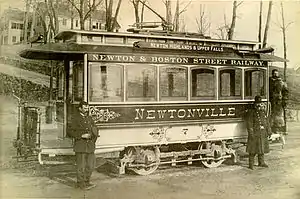
Conveyances designed for public hire are as old as the first ferries, and the earliest public transport was water transport: on land people walked (sometimes in groups and on pilgrimages, as noted in sources such as the Bible and The Canterbury Tales) or (at least in Eurasia and Africa) rode an animal.[8] Ferries appear in Greek mythology—corpses in ancient Greece were buried with a coin underneath their tongue to pay the ferryman Charon to take them to Hades.[9]
Some historical forms of public transport include the stagecoach, traveling a fixed route between coaching inns, and the horse-drawn boat carrying paying passengers, which was a feature of European canals from their 17th-century origins. The canal itself as a form of infrastructure dates back to antiquity – ancient Egyptians certainly used a canal for freight transportation to bypass the Aswan cataract – and the Chinese also built canals for water transportation as far back as the Warring States period[10] which began in the 5th century BCE. Whether or not those canals were used for-hire public transport remains unknown; the Grand Canal in China (begun in 486 BCE) served primarily for shipping grain.
The omnibus, the first organized public transit system within a city, appears to have originated in Paris, France, in 1662,[11] although the service in question, Carrosses à cinq sols, failed a few months after its founder, Blaise Pascal, died in August 1662; omnibuses are next known to have appeared in Nantes, France, in 1826. The omnibus was introduced to London in July 1829.[12]
The first passenger horse-drawn railway opened in 1806: it ran between Swansea and Mumbles in southwest Wales in the United Kingdom.[13] In 1825 George Stephenson built the Locomotion for the Stockton and Darlington Railway in northeast England, the first public steam railway in the world.
The first successful electric streetcar was built for 12 miles of track for the Union Passenger Railway in Richmond, Virginia in 1888. Electric streetcars could carry heavier passenger loads than predecessors, which reduced fares and stimulated greater transit use. Two years after the Richmond success, over thirty two thousand electric streetcars were operating in America. Electric streetcars also paved the way for the first subway system in America. Before electric streetcars, steam powered subways were considered. However, most people believed that riders would avoid the smoke filled subway tunnels from the steam engines. In 1894, Boston built the first subway in the United States, an electric streetcar line in a 1.5-mile tunnel under Tremont Street's retail district. Other cities such as New York quickly followed, constructing hundreds of miles of subway in the following decades.[14]
Types
- Aerial lift
- Maritime transport
- Land transport
- Personal public transport
- Rail transport
- Road transport
Comparing modes
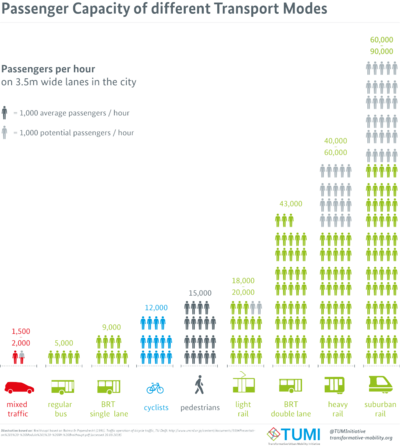
Seven criteria measure the usability of different types of public transport and its overall appeal. The criteria are speed, comfort, safety, cost, proximity, timeliness and directness.[15] Speed is calculated from total journey time including transfers. Proximity means how far passengers must walk or otherwise travel before they can begin the public transport leg of their journey and how close it leaves them to their desired destination. Timeliness is how long they must wait for the vehicle. Directness records how far a journey using public transport deviates from the route.
In selecting between competing modes of transport, many individuals are strongly motivated by direct cost (travel fare/ ticket price to them) and convenience, as well as being informed by habit. The same individual may accept the lost time and statistically higher risk of accident in private transport, together with the initial, running and parking costs. Loss of control, spatial constriction, overcrowding, high speeds/accelerations, height and other phobias may discourage use of public transport.
Actual travel time on public transport becomes a lesser consideration when predictable and when travel itself is reasonably comfortable (seats, toilets, services), and can thus be scheduled and used pleasurably, productively or for (overnight) rest. Chauffeured movement is enjoyed by many people when it is relaxing, safe but not too monotonous. Waiting, interchanging, stops and holdups, for example due to traffic or for security, are discomforting. Jet lag is a human constraint discouraging frequent rapid long-distance east–west commuting, favoring modern telecommunications and VR technologies.
Airline
An airline provides scheduled service with aircraft between airports. Air travel has high speeds, but incurs large waiting times prior to and after travel, and is therefore often only feasible over longer distances or in areas where a lack of ground infrastructure makes other modes of transport impossible. Bush airlines work more similarly to bus stops; an aircraft waits for passengers and takes off when the aircraft is full.
Bus and coach


Bus services use buses on conventional roads to carry numerous passengers on shorter journeys. Buses operate with low capacity (compared with trams or trains), and can operate on conventional roads, with relatively inexpensive bus stops to serve passengers. Therefore, buses are commonly used in smaller cities, towns, and rural areas, and for shuttle services supplementing other means of transit in large cities. Bus rapid transit is an ambiguous term used for buses operating on dedicated right-of-way, much like a light rail. Trolleybuses are electric buses that receive power from overhead wires for mobility. Online Electric Vehicles are buses that run on a conventional battery, but are recharged frequently at certain points via underground wires.[16]
Coach services use coaches (long-distance buses) for suburb-to-CBD or longer-distance transportation. The vehicles are normally equipped with more comfortable seating, a separate luggage compartment, video and possibly also a toilet. They have higher standards than city buses, but a limited stopping pattern.
Train
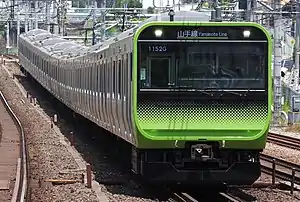
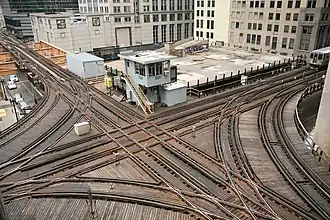
Right: Chicago Transit Authority signal tower 18 guides elevated Chicago 'L' northbound Purple and Brown lines intersecting with westbound Pink and Green lines and the looping Orange line above the Wells and Lake street intersection in the loop.
Passenger rail transport is the conveyance of passengers by means of wheeled vehicles specially designed to run on railways. Trains allow high capacity on short or long distance, but require track, signalling, infrastructure and stations to be built and maintained. Urban rail transit consists of trams, light rail, rapid transit, people movers, commuter rail, monorail, suspension railways and funiculars.
Commuter, intercity, and high-speed rail
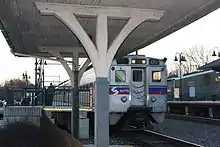
Commuter rail is part of an urban area's public transport; it provides faster services to outer suburbs and neighboring towns and villages. Trains stop at stations that are located to serve a smaller suburban or town center. The stations are often combined with shuttle bus or park and ride systems. Frequency may be up to several times per hour, and commuter rail systems may either be part of the national railway or operated by local transit agencies.
Intercity rail is long-haul passenger services that connect multiple urban areas. They have few stops, and aim at high average speeds, typically only making one of a few stops per city. These services may also be international.
High-speed rail is passenger trains operating significantly faster than conventional rail—typically defined as at least 200 kilometres per hour (120 mph). The most predominant systems have been built in Europe and East Asia, and compared with air travel, offer long-distance rail journeys as quick as air services, have lower prices to compete more effectively and use electricity instead of combustion.[17]
Rapid transit
A rapid transit railway system (also called a metro, underground, or subway) operates in an urban area with high capacity and frequency, and grade separation from other traffic.[18][19]
Systems are able to transport large numbers of people quickly over short distances with little land use. Variations of rapid transit include people movers, small-scale light metro and the commuter rail hybrid S-Bahn. More than 160 cities have rapid transit systems, totalling more than 8,000 km (4,971 mi) of track and 7,000 stations. Twenty-five cities have systems under construction.
Tram
_(14918534190).jpg.webp)
Trams are railborne vehicles that run in city streets or dedicated tracks. They have higher capacity than buses, but must follow dedicated infrastructure with rails and wires either above or below the track, limiting their flexibility.
Light rail
Light rail is a modern development (and use) of the tram, with dedicated right-of-way not shared with other traffic, (often) step-free access and increased speed. Light rail lines are, thus, essentially modernized interurbans.
Personal rapid transit

Personal rapid transit is an automated cab service that runs on rails or a guideway. This is an uncommon mode of transportation (excluding elevators) due to the complexity of automation. A fully implemented system might provide most of the convenience of individual automobiles with the efficiency of public transit. The crucial innovation is that the automated vehicles carry just a few passengers, turn off the guideway to pick up passengers (permitting other PRT vehicles to continue at full speed), and drop them off to the location of their choice (rather than at a stop). Conventional transit simulations show that PRT might attract many auto users in problematic medium-density urban areas. A number of experimental systems are in progress. One might compare personal rapid transit to the more labor-intensive taxi or paratransit modes of transportation, or to the (by now automated) elevators common in many publicly accessible areas.
Cable-propelled transit
Cable-propelled transit (CPT) is a transit technology that moves people in motor-less, engine-less vehicles that are propelled by a steel cable.[20] There are two sub-groups of CPT – gondola lifts and cable cars (railway). Gondola lifts are supported and propelled from above by cables, whereas cable cars are supported and propelled from below by cables.
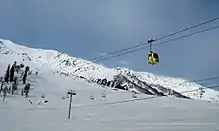
While historically associated with usage in ski resorts, gondola lifts are now finding increased consumption and utilization in many urban areas – built specifically for the purposes of mass transit.[21] Many, if not all, of these systems are implemented and fully integrated within existing public transportation networks. Examples include Metrocable (Medellín), Metrocable (Caracas), Portland Aerial Tram, Roosevelt Island Tramway in New York City, and London's Emirates Air Line.
Ferry
A ferry is a boat used to carry (or ferry) passengers, and sometimes their vehicles, across a body of water. A foot-passenger ferry with many stops is sometimes called a water bus. Ferries form a part of the public transport systems of many waterside cities and islands, allowing direct transit between points at a capital cost much lower than bridges or tunnels, though at a lower speed. Ship connections of much larger distances (such as over long distances in water bodies like the Mediterranean Sea) may also be called ferry services.
Cycleway network
A report published by the UK National Infrastructure Commission in 2018 states that "cycling is mass transit and must be treated as such." Cycling infrastructure is normally provided without charge to users because it is cheaper to operate than mechanised transit systems that use sophisticated equipment and do not use human power.[22]
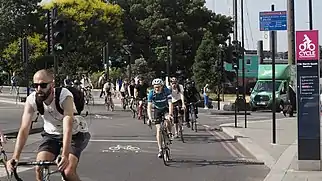
Operation
Infrastructure
All public transport runs on infrastructure, either on roads, rail, airways or seaways. The infrastructure can be shared with other modes, freight and private transport, or it can be dedicated to public transport. The latter is especially valuable in cases where there are capacity problems for private transport. Investments in infrastructure are expensive and make up a substantial part of the total costs in systems that are new or expanding. Once built, the infrastructure will require operating and maintenance costs, adding to the total cost of public transport. Sometimes governments subsidize infrastructure by providing it free of charge, just as is common with roads for automobiles.
Interchanges
Interchanges are locations where passengers can switch from one public transport route to another. This may be between vehicles of the same mode (like a bus interchange), or e.g. between bus and train. It can be between local and intercity transport (such as at a central station or airport).

Timetables
Timetables (or 'schedules' in North American English) are provided by the transport operator to allow users to plan their journeys. They are often supplemented by maps and fare schemes to help travelers coordinate their travel. Online public transport route planners help make planning easier. Mobile apps are available for multiple transit systems that provide timetables and other service information and, in some cases, allow ticket purchase, some allowing to plan your journey, with time fares zones e.g.
Services are often arranged to operate at regular intervals throughout the day or part of the day (known as clock-face scheduling). Often, more frequent services or even extra routes are operated during the morning and evening rush hours. Coordination between services at interchange points is important to reduce the total travel time for passengers. This can be done by coordinating shuttle services with main routes, or by creating a fixed time (for instance twice per hour) when all bus and rail routes meet at a station and exchange passengers. There is often a potential conflict between this objective and optimising the utilisation of vehicles and drivers.
Financing
The main sources of financing are ticket revenue, government subsidies and advertising. The percentage of revenue from passenger charges is known as the farebox recovery ratio. A limited amount of income may come from land development and rental income from stores and vendors, parking fees, and leasing tunnels and rights-of-way to carry fiber optic communication lines.
Fare and ticketing


Most—but not all—public transport requires the purchase of a ticket to generate revenue for the operators. Tickets may be bought either in advance, or at the time of the journey, or the carrier may allow both methods. Passengers may be issued with a paper ticket, a metal or plastic token, or a magnetic or electronic card (smart card, contactless smart card). Sometimes a ticket has to be validated, e.g. a paper ticket has to be stamped, or an electronic ticket has to be checked in.
Tickets may be valid for a single (or return) trip, or valid within a certain area for a period of time (see transit pass). The fare is based on the travel class, either depending on the traveled distance, or based on zone pricing.
The tickets may have to be shown or checked automatically at the station platform or when boarding, or during the ride by a conductor. Operators may choose to control all riders, allowing sale of the ticket at the time of ride. Alternatively, a proof-of-payment system allows riders to enter the vehicles without showing the ticket, but riders may or may not be controlled by a ticket controller; if the rider fails to show proof of payment, the operator may fine the rider at the magnitude of the fare.
Multi-use tickets allow travel more than once. In addition to return tickets, this includes period cards allowing travel within a certain area (for instance month cards), or during a given number of days that can be chosen within a longer period of time (for instance eight days within a month). Passes aimed at tourists, allowing free or discounted entry at many tourist attractions, typically include zero-fare public transport within the city. Period tickets may be for a particular route (in both directions), or for a whole network. A free travel pass allowing free and unlimited travel within a system is sometimes granted to particular social sectors, for example students, elderly, children, employees (job ticket) and the physically or mentally disabled.
Zero-fare public transport services are funded in full by means other than collecting a fare from passengers, normally through heavy subsidy or commercial sponsorship by businesses. Several mid-size European cities and many smaller towns around the world have converted their entire bus networks to zero-fare. The only European capital with free public transport is Tallinn. Local zero-fare shuttles or inner-city loops are far more common than city-wide systems. There are also zero-fare airport circulators and university transportation systems.
Revenue, profit and subsidies
Governments frequently opt to subsidize public transport for social, environmental or economic reasons. Common motivations include the desire to provide transport to people who are unable to use an automobile[23] and to reduce congestion, land use and automobile emissions.[24]
Subsidies may take the form of direct payments for financially unprofitable services, but support may also include indirect subsidies. For example, the government may allow free or reduced-cost use of state-owned infrastructure such as railways and roads, to stimulate public transport's economic competitiveness over private transport, that normally also has free infrastructure (subsidized through such things as gas taxes). Other subsidies include tax advantages (for instance aviation fuel is typically not taxed), bailouts if companies that are likely to collapse (often applied to airlines) and reduction of competition through licensing schemes (often applied to taxis and airlines). Private transport is normally subsidized indirectly through free roads and infrastructure,[25] as well as incentives to build car factories[26] and, on occasion, directly via bailouts of automakers.[27][28]
Land development schemes may be initialized, where operators are given the rights to use lands near stations, depots, or tracks for property development. For instance, in Hong Kong, MTR Corporation Limited and KCR Corporation generate additional profits from land development to partially cover the cost of the construction of the urban rail system.[29]
Some supporters of mass transit believe that use of taxpayer capital to fund mass transit will ultimately save taxpayer money in other ways, and therefore, state-funded mass transit is a benefit to the taxpayer. Some research has supported this position,[30] but the measurement of benefits and costs is a complex and controversial issue.[31] A lack of mass transit results in more traffic, pollution,[32][33][34] and road construction[35] to accommodate more vehicles, all costly to taxpayers;[36] providing mass transit will therefore alleviate these costs.[37] (Perhaps,[38][39][40][41] although right-wing think tanks disagree[42][43])
Safety and security
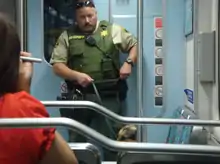
Relative to other forms of transportation, public transit is safe (with a low crash risk) and secure (with low rates of crime).[44] The injury and death rate for public transit is roughly one-tenth that of automobile travel.[44] A 2014 study noted that "residents of transit-oriented communities have about one-fifth the per capita crash casualty rate as in automobile-oriented communities" and that "Transit also tends to have lower overall crime rates than automobile travel, and transit improvements can help reduce overall crime risk by improving surveillance and economic opportunities for at-risk populations."[44]
Although relatively safe and secure, public perceptions that transit systems are dangerous endure.[44] A 2014 study stated that "Various factors contribute to the under-appreciation of transit safety benefits, including the nature of transit travel, dramatic news coverage of transit crashes and crimes, transit agency messages that unintentionally emphasize risks without providing information on its overall safety, and biased traffic safety analysis."[44]
Some systems attract vagrants who use the stations or trains as sleeping shelters, though most operators have practices that discourage this.[45]
Impact
Accessibility
Public transport is means of independent transport for individuals (without walking or bicycling) such as children too young to drive, the elderly without access to cars and the infirm such as wheelchair users. Kneeling buses, low-floor access boarding on buses and light rail has also enabled greater access for the disabled in mobility. In recent decades low-floor access has been incorporated into modern designs for vehicles. In economically deprived areas, public transport increases individual accessibility to transport where private means are unaffordable.
Environmental

Although there is continuing debate as to the true efficiency of different modes of transportation, mass transit is generally regarded as significantly more energy efficient than other forms of travel. A 2002 study by the Brookings Institution and the American Enterprise Institute found that public transportation in the U.S uses approximately half the fuel required by cars, SUVs and light trucks. In addition, the study noted that "private vehicles emit about 95 percent more carbon monoxide, 92 percent more volatile organic compounds and about twice as much carbon dioxide and nitrogen oxide than public vehicles for every passenger mile traveled".[47]
Studies have shown that there is a strong inverse correlation between urban population density and energy consumption per capita, and that public transport could facilitate increased urban population densities, and thus reduce travel distances and fossil fuel consumption.[48]
Supporters of the green movement usually advocate public transportation, because it offers decreased airborne pollution compared to automobiles. A study conducted in Milan, Italy, in 2004 during and after a transportation strike serves to illustrate the impact that mass transportation has on the environment. Air samples were taken between 2 and 9 January, and then tested for methane, carbon monoxide, non-methane hydrocarbons (NMHCs), and other gases identified as harmful to the environment. The figure below is a computer simulation showing the results of the study "with 2 January showing the lowest concentrations as a result of decreased activity in the city during the holiday season. 9 January showed the highest NMHC concentrations because of increased vehicular activity in the city due to a public transportation strike."[49]
Based on the benefits of public transport, the green movement has affected public policy. For example, the state of New Jersey released Getting to Work: Reconnecting Jobs with Transit.[50] This initiative attempts to relocate new jobs into areas with higher public transportation accessibility. The initiative cites the use of public transportation as being a means of reducing traffic congestion, providing an economic boost to the areas of job relocation, and most importantly, contributing to a green environment by reducing carbon dioxide (CO2) emissions.
Using public transportation can result in a reduction of an individual's carbon footprint. A single person, 20-mile (32 km) round trip by car can be replaced using public transportation and result in a net CO2 emissions reduction of 4,800 pounds (2,200 kg) per year.[51] Using public transportation saves CO2 emissions in more ways than simply travel as public transportation can help to alleviate traffic congestion as well as promote more efficient land use. When all three of these are considered, it is estimated that 37 million metric tons of CO2 will be saved annually.[51] Another study claims that using public transit instead of private in the U.S. in 2005 would have reduced CO2 emissions by 3.9 million metric tons and that the resulting traffic congestion reduction accounts for an additional 3.0 million metric tons of CO2 saved.[52] This is a total savings of about 6.9 million metric tons per year given the 2005 values.
In order to compare energy impact of public transportation to private transportation, the amount of energy per passenger mile must be calculated. The reason that comparing the energy expenditure per person is necessary is to normalize the data for easy comparison. Here, the units are in per 100 p-km (read as person kilometer or passenger kilometer). In terms of energy consumption, public transportation is better than individual transport in a personal vehicle.[53] In England, bus and rail are popular methods of public transportation, especially in London. Rail provides rapid movement into and out of the city of London while busing helps to provide transport within the city itself. As of 2006–2007, the total energy cost of London's trains was 15 kWh per 100 p-km, about 5 times better than a personal car.[54] For busing in London, it was 32 kWh per 100 p-km, or about 2.5 times that of a personal car.[54] This includes lighting, depots, inefficiencies due to capacity (i.e., the train or bus may not be operating at full capacity at all times), and other inefficiencies. Efficiencies of transport in Japan in 1999 were 68 kWh per 100 p-km for a personal car, 19 kWh per 100 p-km for a bus, 6 kWh per 100 p-km for rail, 51 kWh per 100 p-km for air, and 57 kWh per 100 p-km for sea.[54] These numbers from either country can be used in energy comparison calculations or life cycle assessment calculations.
Public transportation also provides an arena to test environmentally friendly fuel alternatives, such as hydrogen-powered vehicles. Swapping out materials to create lighter public transportation vehicles with the same or better performance will increase environmental friendliness of public transportation vehicles while maintaining current standards or improving them. Informing the public about the positive environmental effects of using public transportation in addition to pointing out the potential economic benefit is an important first step towards making a difference.
Land use
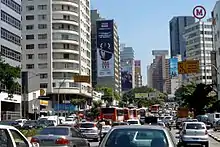
Dense areas with mixed-land uses promote daily public transport use while urban sprawl is associated with sporadic public transport use. A recent European multi-city survey found that dense urban environments, reliable and affordable public transport services, and limiting motorized vehicles in high density areas of the cities will help achieve much needed promotion of public transport use.[55]
Urban space is a precious commodity and public transport utilises it more efficiently than a car dominant society, allowing cities to be built more compactly than if they were dependent on automobile transport.[56] If public transport planning is at the core of urban planning, it will also force cities to be built more compactly to create efficient feeds into the stations and stops of transport.[4][57] This will at the same time allow the creation of centers around the hubs, serving passengers' daily commercial needs and public services. This approach significantly reduces urban sprawl. Public land planning for public transportation can be difficult but it is the State and Regional organizations that are responsible to planning and improving public transportation roads and routes. With public land prices booming, there must be a plan to using the land most efficiently for public transportation in order to create better transportation systems. Inefficient land use and poor planning leads to a decrease in accessibility to jobs, education, and health care.[58]
Societal
The consequences for wider society and civic life, is public transport breaks down social and cultural barriers between people in public life. An important social role played by public transport is to ensure that all members of society are able to travel without walking or cycling, not just those with a driving license and access to an automobile—which include groups such as the young, the old, the poor, those with medical conditions, and people banned from driving. Automobile dependency is a name given by policy makers to places where those without access to a private vehicle do not have access to independent mobility.[60]
Above that, public transportation opens to its users the possibility of meeting other people, as no concentration is diverted from interacting with fellow-travelers due to any steering activities. Adding to the above-said, public transport becomes a location of inter-social encounters across all boundaries of social, ethnic and other types of affiliation.
Economic

Investment in public transport has secondary positive effects on the local economy, with between $4[61] and $9 of economic activity resulting from every dollar spent.[5] Many businesses rely on access to a transit system, in particular in cities and countries where access to cars is less widespread, businesses which require large numbers of people going to a same place may not be able to accommodate a large number of cars (concert venues, sport stadia, airports, exhibitions centres,...), or businesses where people are not able to use a car (bars, hospitals, or industries in the tourism sector whose customers may not have their cars). Transit systems also have an effect on derived businesses: commercial websites have been founded, such as Hopstop.com, that give directions through mass transit systems; in some cities, such as London, products themed on the local transport system are a popular tourist souvenir. Research in the Washington, DC area shows that public transport does a better job of providing high-skill residents with access to high-skill jobs than it does mid-skill residents to mid-skill jobs and low-skill residents to low-skill jobs.[62]
Social issues
Because night trains or coaches can be cheaper than motels, homeless persons sometimes use these as overnight shelters, as with the famous Line 22 ("Hotel 22") in Silicon Valley.[63][64]
See also
- 3D Express Coach
- Finnish models of public transport
- International Association of Public Transport
- Passenger load factor
- Patronage (transport)
- Private transport
- Public transport bus service
- Public transport route planner
- Public transport timetable
- Sustainable transport
- Transit district
- Transit pass
- Transit police
- List of urban transit advocacy organisations
- Transit watchdog
- Transportation engineering
- Hitchhiking
References
- "public transport". English Oxford Living Dictionaries. Oxford University Press. Archived from the original on 31 January 2018. Retrieved 30 January 2018.
Buses, trains, and other forms of transport that are available to the public, charge set fares, and run on fixed routes.
- "public transport in British". Collins English Dictionary. HarperCollins. Archived from the original on 2 December 2018. Retrieved 30 January 2018.
a system of buses, trains, etc, running on fixed routes, on which the public may travel
- Joseph L. Schofer. "Mass transit". Encyclopædia Britannica. Encyclopædia Britannica. Archived from the original on 31 January 2018. Retrieved 30 January 2018.
Mass transit, also called mass transportation, or public transportation, the movement of people within urban areas using group travel technologies such as buses and trains.
- McLeod, Sam (2017). "Urban Public Transport: Planning Principles and Emerging Practice". Journal of Planning Literature. 32 (3): 223–239. doi:10.1177/0885412217693570. S2CID 157431405.
- Calimente, John (2012). "Rail integrated communities in Tokyo". Journal of Transport and Land Use. 5. doi:10.5198/jtlu.v5i1.280.
- "Lessons from Japanese Experiences of Roles of Public and Private Sectors in Urban Transport". Japan Railway & Transport Review. Archived from the original on 26 October 2017. Retrieved 14 December 2013.
- In the Americas and Oceania, beasts of burden were generally not as large, although the Incas did use llamas as pack animals. See Pre Columbian Wheels.
- Gods, Goddesses, and Mythology. Marshall Cavendish. 1 January 2005. ISBN 9780761475644 – via Internet Archive.
- Needham, Joseph. (1986). Science and Civilization in China: Volume 4, Physics and Physical Technology, Part 3, Civil Engineering and Nautics. Taipei: Caves Books, Ltd. ISBN 0-521-07060-0
- web-page (in French) at http://www.herodote.net/histoire/evenement.php?jour=18260810 Archived 16 October 2010 at the Wayback Machine. Retrieved 13 June 2008.
- "The London Omnibus". Knowledgeoflondon.com. Archived from the original on 1 November 2011. Retrieved 21 October 2011.
- "Early Days of Mumbles Railway". BBC. 15 February 2007. Archived from the original on 27 March 2009. Retrieved 19 September 2007.
- Young, Jay (2 March 2015). "Infrastructure: Mass Transit in 19th- and 20th-Century Urban America". Oxford Research Encyclopedia of American History. doi:10.1093/acrefore/9780199329175.001.0001 (inactive 14 January 2021). Archived from the original on 29 November 2018. Retrieved 28 November 2018.CS1 maint: DOI inactive as of January 2021 (link)
- Humphreys, Pat (17 December 2016). "City Transport in the 2020s". Transport and Travel. Archived from the original on 2 February 2017. Retrieved 20 January 2017.
- "KAIST Online Electric Vehicle". Gizmag.com. 20 August 2009. Archived from the original on 13 August 2011. Retrieved 21 October 2011.
- Eli (26 May 2010). "High Speed Train VS Airplane". Tech the Future. Archived from the original on 4 March 2016. Retrieved 21 October 2011.
- "Rapid transit". Merriam-Webster. Archived from the original on 27 June 2013. Retrieved 27 February 2008.; "Metro". International Association of Public Transport. Archived from the original on 27 June 2013. Retrieved 27 February 2008.
- "Glossary of Transit Terminology". American Public Transportation Association. Archived from the original on 27 September 2007. Retrieved 27 February 2008.
- – The Gondola Project Archived 2 February 2011 at the Wayback Machine Basic Lesson 1: What is Cable Propelled Transit Retrieved on 7 November 2009
- – Planetizen Archived 28 December 2010 at the Wayback Machine South America Incubates Cable Propelled Transit Retrieved on 10 June 2010
- Andrew Gilligan. "Running out of road". National Infrastructure Commission. National Infrastructure Commission. Archived from the original on 6 July 2018. Retrieved 30 January 2018.
cycling is mass transit and must be treated as such.
- Litman, Todd (June 2014). "Evaluating Transportation Equity: Guidance for Incorporating Distributional Impacts in Transportation Planning" (PDF). Archived (PDF) from the original on 10 January 2017.
- Litman, Todd (September 2016). "Evaluating Public Transit Benefits and Costs" (PDF). Archived (PDF) from the original on 10 January 2017.
- Subsidies in Oregon Highway Transportation – Publications Index. Pubsindex.trb.org. 31 January 1983. ISBN 9780309033619. Archived from the original on 29 September 2011. Retrieved 21 October 2011.
- "Canadian auto subsidies: Money for nothing? | vox – Research-based policy analysis and commentary from leading economists". Voxeu.org. 21 December 2008. Archived from the original on 28 October 2011. Retrieved 21 October 2011.
- "General Motors bailout details". Chicago Sun-Times. Archived from the original on 18 April 2010.
- Roth, Alisa (4 December 2008). "Auto bailout talk is history repeating | Marketplace From American Public Media". Marketplace.publicradio.org. Archived from the original on 11 July 2012. Retrieved 21 October 2011.
- Verougstraete, Matheiu; Zeng, Han (July 2014). "Land Value Capture Mechanism: The Case of the Hong Kong Mass Transit Railway" (PDF). www.unescap.org. United Nations Economic and Social Commission for Asia and the Pacific. Archived (PDF) from the original on 25 October 2016.
- For examples, see http://onlinepubs.trb.org/onlinepubs/tcrp/tcrp_rpt_49.pdf Archived 6 July 2010 at the Wayback Machine and http://onlinepubs.trb.org/onlinepubs/tcrp/tcrp_rpt_34.pdf Archived 5 July 2010 at the Wayback Machine
- "GAO-05-423SP Highlights of an Expert Panel: The Benefits and Costs of Highway and Transit Investments" (PDF). Archived (PDF) from the original on 18 December 2011. Retrieved 21 October 2011.
- "Transit key in pollution, poverty fights". The Star. Toronto. 12 May 2008. Archived from the original on 22 October 2012.
- "CDC – Healthy Places – Respiratory Health and Air Pollution". Cdc.gov. Archived from the original on 15 October 2011. Retrieved 21 October 2011.
- "Microsoft Word – 5_10-Air" (PDF). Archived (PDF) from the original on 6 July 2010. Retrieved 29 October 2012.
- "Highway Construction Cost / Inflation Issues – Contract Admin – Construction – FHWA". Fhwa.dot.gov. 22 August 2011. Archived from the original on 23 October 2011. Retrieved 21 October 2011.
- Victoria Transport Public Institute. "Victoria Transport Institute – Transportation Cost and Benefit Analysis". Vtpi.org. Archived from the original on 9 October 2011. Retrieved 21 October 2011.
- "Tcall" (PDF). www.vtpi.org. Archived (PDF) from the original on 6 July 2010. Retrieved 9 April 2010.
- "Online TDM Encyclopedia – Congestion Reduction". Vtpi.org. Archived from the original on 10 November 2011. Retrieved 21 October 2011.
- "WSDOT – Moving Washington – A program to fight congestion". Wsdot.wa.gov. Archived from the original on 19 October 2011. Retrieved 21 October 2011.
- "Transportation Invest in Our Future – Surface Transportation Policy Recommendations". Transportation1.org. Archived from the original on 10 March 2013. Retrieved 21 October 2011.
- RAND Corporation (16 September 2010). "Reducing Traffic Congestion in Los Angeles". RAND. Archived from the original on 17 September 2011. Retrieved 21 October 2011.
- "Page Not Found " Search " Washington Policy Center". 13 March 2016. Archived from the original on 13 March 2016. Cite uses generic title (help)
- Archived 12 April 2010 at the Wayback Machine
- Todd Litman, A New Transit Safety Narrative Archived 12 December 2019 at the Wayback Machine, Journal of Public Transportation, Vol. 17, No. 4 (2014), pp. 114-134.
- Needle et al., 1997: 10–13
- "Van Hool presents the ExquiCity Design Mettis". Archived from the original on 5 June 2013. Retrieved 5 June 2012.
- Lyndsey Layton, "Study Lists Mass Transit Benefits", The Washington Post, 17 July 2002, Page B05
- Newman, 1999
- Barletta, Barbara; Dabdub, Donald; Blake, Donald R.; Rowand, F. Sherwood; Nissenson, Paul; Meinardi, Simone (2008). "Influence of the public transportation system on the air quality of a major urban center. A case study: Milan, Italy". Atmospheric Environment. 42 (34): 7915–7923. Bibcode:2008AtmEn..42.7915M. doi:10.1016/j.atmosenv.2008.07.046.
- New Jersey Future. "Getting to Work: Reconnecting Jobs with Transit. Archived 20 July 2011 at the Wayback Machine" New Jersey Future.1 November 2008.New Jersey Environmental Digital Library. 7 December 2009
- Public Transportation Reduces Greenhouse Gases and Conserves Energy.
- Todd Davis; Monica Hale. "Public Transportation's Contribution to U.S. Greenhouse Gas Reduction." Sept. 2007. p. 25
- David JC MacKay. "Sustainable Energy Without the Hot Air." 2009. p. 120 www.withouthotair.com
- David JC MacKay. "Sustainable Energy Without the Hot Air." 2009. p. 121 www.withouthotair.com
- Gascon, Mireia (August 2020). "What explains public transport use? Evidence from seven European cities". Transport Policy. 99: 362–374. doi:10.1016/j.tranpol.2020.08.009.
- "UITP – Public transport alleviates congestion" (PDF). Archived from the original (PDF) on 10 September 2010. Retrieved 21 October 2011.
- "UITP Advocacy". Uitp.org. Archived from the original on 10 March 2012. Retrieved 21 October 2011.
- Kulyk, Walter (2002). Urban Public Transportation Systems: Ensuring Sustainability Through Mass Transit. American Society of Civil Engineers. pp. 408–409. ISBN 978-0-7844-0717-2.
- "Public transportation: Not only for the poor". The Himalayan Times. 1 April 2014. Archived from the original on 10 April 2014. Retrieved 1 April 2014.CS1 maint: bot: original URL status unknown (link)
- Litman, T. (1999). "The Costs of Automobile Dependency and the Benefits of Balanced Transport". Victoria Public Policy Institute. Cite journal requires
|journal=(help) - "The Business Case for Investment in Public Transportation" (PDF). APTA. March 2015. Archived from the original (PDF) on 10 March 2016. Retrieved 3 March 2016.
- "Brookings Institution, Connecting to Opportunity: Access to Jobs via Transit in the Washington, D.C. Region, November 2012". Archived from the original on 23 January 2013. Retrieved 14 November 2012.
- Jane Lii, "Refuge on the Road: Homeless Find Nighttime Haven – The No. 22 Bus From Menlo Park To San Jose", San Jose Mercury News, 9 January 2000, 1A.
- Cathy Newman, "Silicon Valley: Inside the Dream Incubator", National Geographic 200, no. 6 (December 2001): 52–76.
Further reading
- Hess, D. 2007. "What is a clean bus? Object conflicts in the greening of urban transit." Sustainability: Science, Practice, & Policy 3(1):45–58.
- Needle, Jerome A.; Transportation Security Board & Cobb, Renée M. (1997). Improving Transit Security. Transportation Security Board. ISBN 978-0-309-06013-4.
- Newman, Peter; Jeffrey R. Kenworthy (1999). Sustainability and Cities: Overcoming Automobile Dependence. Island Press. ISBN 978-1-55963-660-5.
- Ovenden, Mark (2007). Transit Maps of the World. London: Penguin. p. 7. ISBN 978-0-14-311265-5.
- Valderrama, A.; Beltran, I. (2007). "Diesel versus compressed natural gas in Transmilenio-Bogotá: innovation, precaution, and distribution of risk". Sustainability: Science, Practice, & Policy 3(1):59–67. Archived from the original on 30 June 2007. Retrieved 2 March 2017.
External links
| Wikimedia Commons has media related to Public transport. |
- International Association of Public Transport
- US High Speed Rail Association
- Transit Standards - Knowledge base on branding, digital strategy, and graphic standards for public transit, compiled by Stewart Mader. Contains over 100 resources and examples, including 30 graphics standards manuals from transit agencies worldwide.
